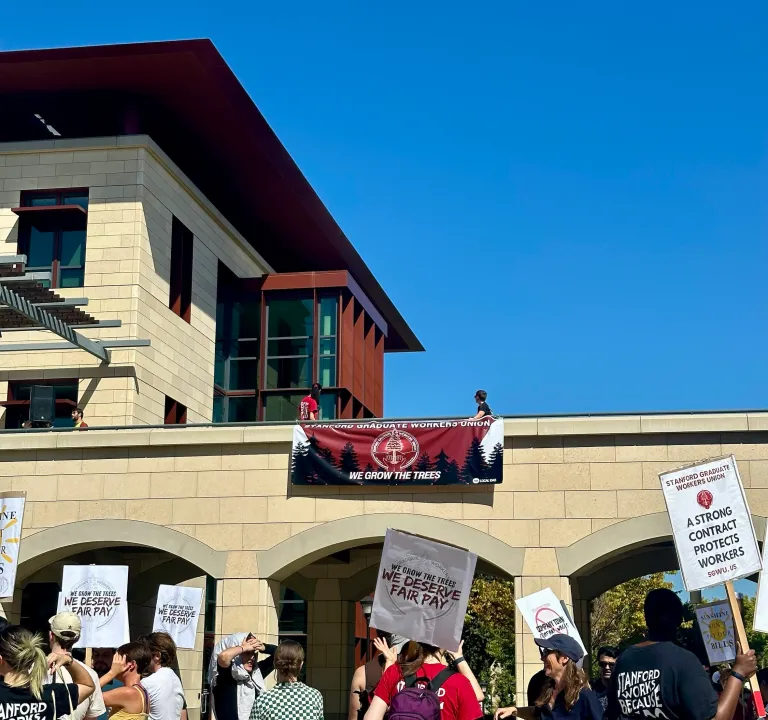The Stanford Graduate Workers Union (SGWU) reached a tentative agreement with Stanford last Tuesday. Now, the agreement is subject to an ongoing ratification vote that will expire Thursday. Voting against this agreement is graduate workers’ last chance to get a living wage and protection of fellows’ rights as workers for the next three years.
How to vote
You can sign a membership card here. Everyone must sign a new card to vote. Upon signing, you will be sent a ballot in the next 24 hours. The deadline to vote is Thursday.
Fellow inclusion
If the current tentative agreement is ratified, thousands of graduate workers paid by research fellowships will not receive the protections against discrimination, harassment and power abuse — which the union’s bargaining committee claimed as a main “bargaining win.”
Winning fellow inclusion is possible, as the University of Minnesota’s Graduate Labor Union did so in their own tentative agreement. Although SGWU’s bargaining committee claims that acceptance of the current agreement will lead to improved negotiations with Stanford on fellow inclusion in the future, there is nothing to imply this. Instead, now is the best chance that graduate workers have to include research fellows in the bargaining unit.
Voting yes on this tentative agreement means accepting that fellows are not graduate workers, even if they often do the same work as research assistants. Voting no, by contrast, will continue this fight, which is the most impactful that organizing can achieve!
Wages
When the contract between Stanford and SGWU becomes ratified, you will pay the union 1.44% of your wage if you are a research assistant, course assistant or teaching assistant. This is true no matter whether you are a member of the union or not.
Considering this fact, and considering that rent will increase by 4.5%, 4.0% and 3.5% in the next three years, respectively, the 4.75%, 4.25% and 3.75% raises in the next three years as specified in the current tentative agreement are effectively pay cuts every year.
The stipend in the tentative agreement is about $11,000 below the Department of Housing and Urban Development’s Very Low Income Level, according to a table that the union presented in July; this wage gap is 50% more than that of peer institutions.
In other words, Stanford is sending the message that we are not worthy of a living wage. This wage gap is especially harmful to people from low income communities and families with children. The current agreement will guarantee that students remain in poverty without improvement in three years time.
It is important to note Stanford has increased the stipend for graduate workers every year. The average rate of increase in the last 10 years is 4.4%. When adding in union dues or agency fees, the pay raises promised in SGWU’s current tentative agreement over the next three years will be lower than this average rate.

| Past minimum stipend for first-year graduate workers in the Department of Chemistry | 2014 | $34796 |
| 2015 | $36192 | |
| 2016 | $37836 | |
| 2017 | $39444 | |
| 2018 | $41316 | |
| 2019 | $44616 | |
| 2020 | $46620 | |
| 2021 | $48558 | |
| 2022 | $50600 | |
| 2023 | $52092 | |
| Minimum stipend under the tentative agreement, with union dues | 2024 | $53274 |
| 2025 | $55537 | |
| 2026 | $57618 |
Union organizing
45% of the graduate workers participated in the strike authorization vote, of which 89% voted for a strike. The bargaining committee stated in town hall meetings last week that they called off the strike because they thought that those who did not vote were ambivalent as to whether or not to strike.
The truth, however, is that the bargaining committee did not reach enough people during the strike authorization vote. From what I observed, the number of people voting was still increasing quickly on the last day of the vote. More people would have voted for strike authorization if we had continued organizing. In the end, the voting period was arbitrarily set by the bargaining committee, which turned out to be too early.
Now, the bargaining committee is doing something very similar. It has set the ratification vote of the tentative agreement to start and end within ten days of reaching the agreement. This leaves graduate workers insufficient time to have an informed decision on the vote, and gives opposing organizers a huge disadvantage. Other unions, such as the one formerly representing graduate workers at Columbia University, have used this tactic to suppress opposition to bad contracts in the past.
Summary
This tentative agreement is not the best offer graduate students could receive — it is simply the best offer our leaders thought they were prepared to organize. We all deserve more, and voting no is the last chance to continue this fight before we lose our ability to strike for three years.
Yizhen Chen is a second-year Ph.D. student in mathematics. Reagan Nicole Ross is a fifth-year Ph.D. student in communication.
Correction: A previous version of this article inaccurately represented graduate workers’ pay raise in the next three years as specified in the tentative agreement.
